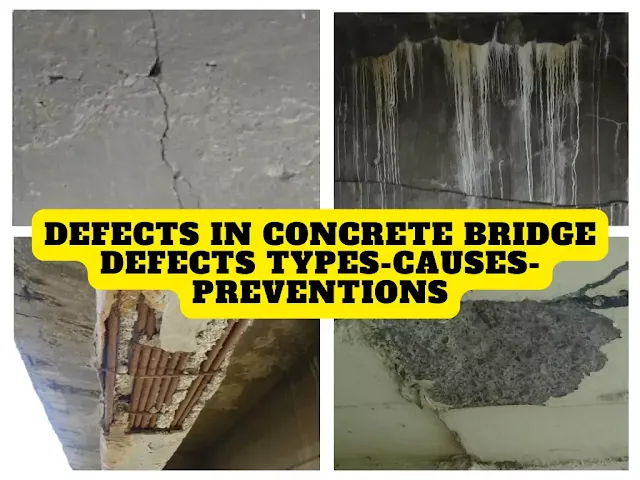Defects In Concrete Bridge Structures || Bridge Defects Type-Causes And Preventions:
The main purpose of a bridge structure is to serve us without any failure or major issue during its service life. If we do not take care of minor defects in a bridge structure it will lead to a major defect. One or more major defects lead to bridge structure into failure stage during its service life. Some common defects in concrete bridges are cracking, spalling, scaling, honeycomb, corrosion, delaminations, carbonation, chemical effect, leaching, shrinkage, creeping, etc.
Spalling In Concrete:
Spalling can be defined as in a simple term that concrete chunk or area of concrete is cracked and delaminated from the mother concrete. Mother concrete or steel reinforcement may be in exposure condition. In case of aggressive environment, spalling leads to excessive corrosion to the exposed steel reinforcements. Spalling in concrete leads to degrade the structural members and affect the concrete mechanical strength and it's durability.
Scaling in Concrete:
Scaling in Concrete can define as loss of surface mortar from the outer face of concrete members. Scaling in Concrete can be occured due to weather effects and low grade of cement concrete. High scaling in concrete leads to exposing the course aggregates.
Honeycomb in Concrete:
Honeycomb in concrete can define as void in concrete or cavities in mass concrete where concrete can not reach to fill during construction. It may be inside of concrete or may be outer face of mass concrete. The main reason of honeycomb in concrete is improper vibration and low workability of concrete. Honeycomb in concrete is seen like honey bees nest from the outer face. Honeycomb in concrete makes exposing course aggregates and steel reinforcements. Honeycomb leads to rust and corrosion to steel reinforcements.
Cracks in concrete:
Cracking is a common defect in any concrete structure. Thermal cracks (hairline cracks, shrinkage cracks) are easily found in any concrete structure.
Thermal cracks can be developed in concrete due to thermal variation at different Concrete layers and rapid loss of water during concrete hardening. Thermal cracks are not affecting on the concrete structures but need to take attention.
Minor cracks, major cracks, and widen cracks may be developed in structural members due to shear stresses, flexural moment, unequal settlement of foundation, earthquake etc. These type of cracks in concrete structures shall take care as soon as possible to prevent further propagation of any distress.
Carbonation in concrete:
During hydration of concrete calcium hydroxide Ca(OH)2 make a protective layer around the steel reinforcement bars and protect the steel bars from rust and corrosion.
Atmospheric Carbon dioxide can interact with calcium hydroxide Ca(OH)2 due to insufficient clear cover or porosity/void concrete. Form calcium carbonate due to the reaction of calcium hydroxide Ca(OH)2 and carbon dioxide (Co2) which make shrinkage cracks in concrete. This process is known as carbonation. This process reduces the alkalinity in concrete and breaks the protective layer around steel reinforcements. without protective layer, iron reacts with moisture and oxygen and produces iron oxides or rust. Hence carbonation leads to corrosion in concrete.
Carbon dioxide is easily soluble in high humidity. High humidity accelerates the carbonation process in concrete. Insufficient clear cover and void in concrete will also accelerate the carbonation process.
Corrosion in Reinforced Concrete:
Cause of corrosion in reinforced concrete, precaution, and remedial measures have been described in another post. Please click the following links to know more.









0 Comments
Please feel free to suggest us to improve the content (Is it informative or not)